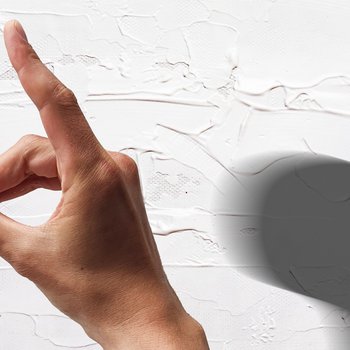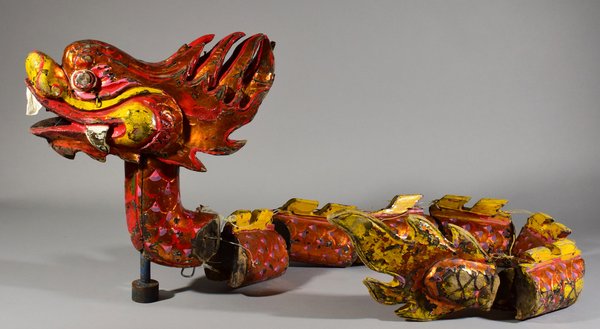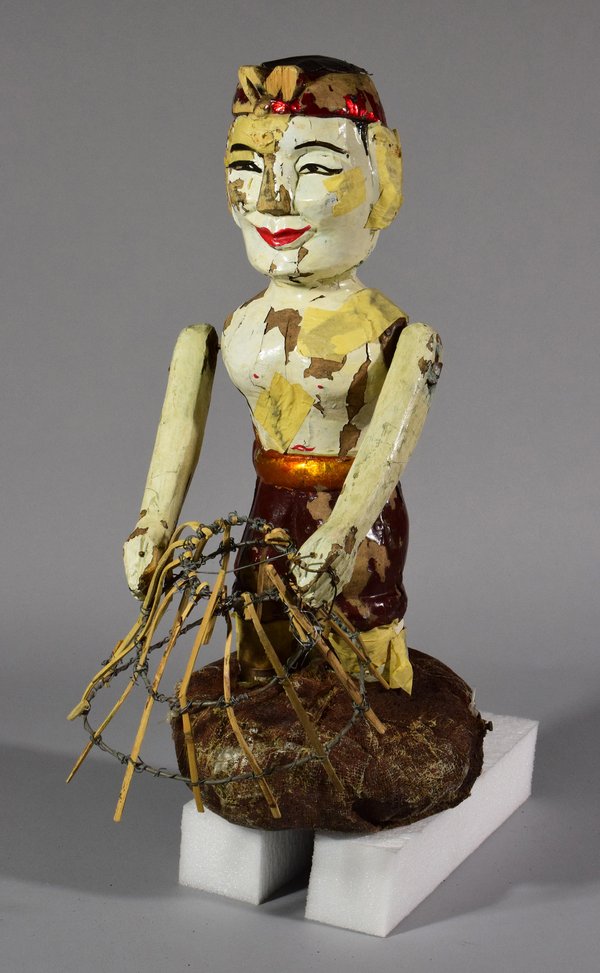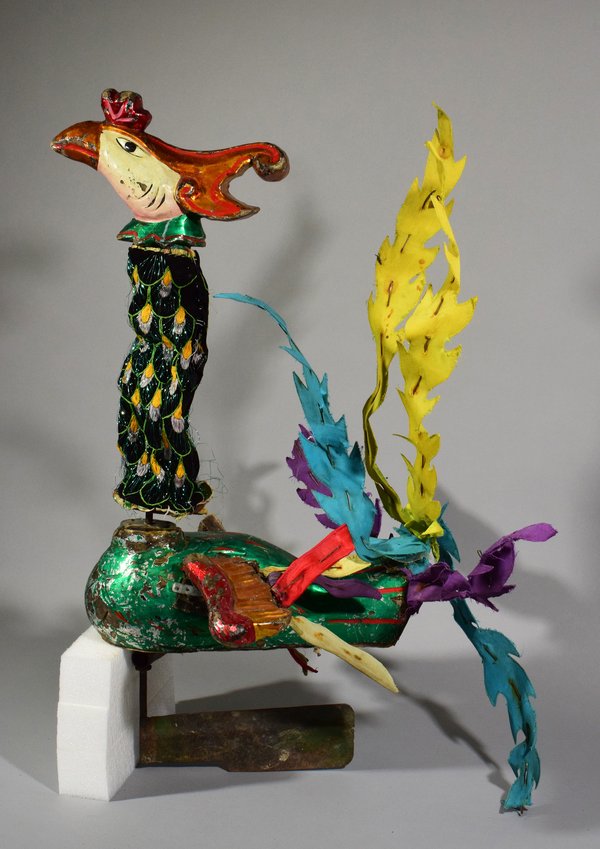Water puppetry (Múa Rối Nước) is a theatrical genre that goes back centuries1 and is in fact only practised and maintained in Vietnam (and especially the capital, Hanoi). Its roots are uncertain; they may be found in China, but the art has long since disappeared there. Shows were once put on in village ponds, for example to mark spring or harvest festivals. Today they are performed in pools that are permanently set up in the open air or in theatres. At the back of the pool, there is always a building like a palace or pagoda, with bamboo mats hanging in front of the entrance. The puppeteers are behind this curtain; they have a view of the pool but are not visible to the audience. They stand waist-deep in the water and work the figures using long sticks that are hidden just below the surface of the water, as are the floats that buoy up the puppets. From behind the pool, strings are also used to control the puppets’ individual movements (their heads and arms, wielding tools, playing instruments, etc.). Though every troupe adds its own special touches, most of the show comprises a standardised repertoire of brief sketches: everyday farming scenes, legends or fables. The performance is accompanied by singing and music played by a small orchestra at the side of the pool.
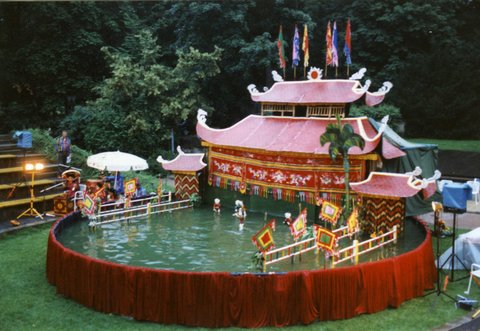
Olaf Bernstengel: Bühnenaufbau beim Wasserpuppentheatergastspiel des Staatlichen Puppentheaters Hanoi, 1988 im Großen Garten in Dresden
© Staatliche Kunstsammlungen Dresden, Puppentheatersammlung
The set of figures that are now finding a new home in Dresden were purchased for the Puppentheatersammlung from a private owner by the friends association MUSEIS SAXONICIS USUI Freunde der Staatlichen Kunstsammlungen Dresden e. V. For the collection, this is the biggest addition in the field of non-European puppetry in its almost 70‑year history. It is also unusual for such an extensive ensemble of water puppets to be kept outside Vietnam.2 The joy this new acquisition brings is overshadowed by one tiny cloud: with some 140 human figures, animals, boats, etc., the set is large, but it is not complete – and the puppet most sorely missed is an absolute must for a typical water puppet show: Tễu.
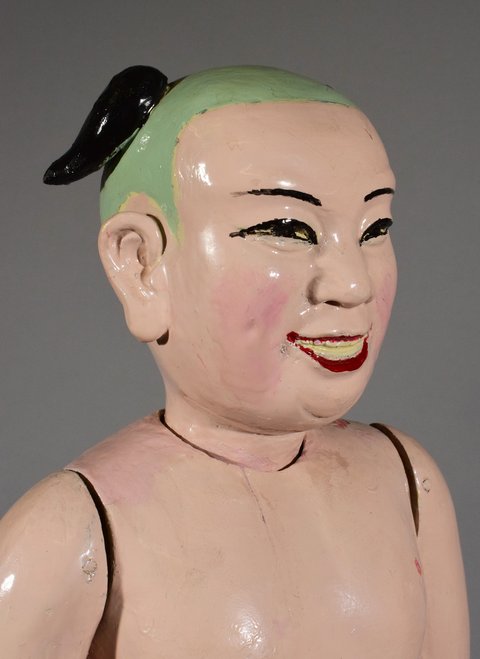
Chu Teu, Ansager (Hanoi um 1975) Holz, geschnitzt, bemalt
© Staatliche Kunstsammlungen Dresden, Puppentheatersammlung
Tễu – sometimes also known as “chú tễu” (“Uncle Tễu”) – is the jester, announcer and host of a Vietnamese water puppet show, and sometimes also the clown that comes on between acts. He creates a connection between the audience and the puppets in the pool. On one hand, he is one of the “common folk” and can make fun of the “upper crust”; on the other, he comes from the heavens and looks down on earthly absurdities through the lens of reason. Though they do not play exactly the same role, Tễu can be compared with Kasper, Punch or other jokers found in European puppetry: iconic representatives of specific theatre traditions, familiar faces that are much-loved by the audience. His absence is thus a bitter pill that can in fact only be swallowed for one reason: Tễu is already here! The story of how a Tễu entered the Dresden collection starts almost 50 years ago in East Berlin: Inge Borde-Klein (1917–2006), the GDR’s leading amateur puppeteer3 and a celebrated author of puppet plays, travelled to North Vietnam for three weeks at the end of November 1975 to study the art. There, her dream came true of attending a water puppetry show. European experts were aware of these in theory, but few had ever seen one.4 In a seven-page travel report for “Mitteilungen”, the Puppentheatersammlung periodical, Inge Borde-Klein described being invited by the “Central Puppetry Group” in Hanoi on 1 December 1975.5 A reception with fireworks and a lecture on the art of Vietnamese puppetry were initially followed by excerpts from a marionette show and a rod puppet performance. The “Water Marionette Show” was then performed as the main highlight of her visit.
The show began with a traditional flag segment, except that this time, the flag of the GDR was raised “in honour of the guest”. Tễu then already appeared in the second segment: “Before the applause had died down, the compère swept forward, turned his head left and right, lifted his arms and – smiled. Though I sadly could not follow the flood of words that accompanied his appearance, we all picked up on the happiness he spread. CHU TEU addressed all sides, then retreated. A series of acts followed.”6 Inge Borde-Klein was fascinated by this theatrical genre, and especially taken with its beaming protagonist. She was thus all the more delighted by the surprise her hosts organised to round off her trip: “At the reception held at the GDR Embassy to mark our departure, there was another minor sensation. The head of the Central Puppetry Group had previously announced that a gift was being prepared for me. As ceremoniously as if he were unveiling a monument, he opened the wooden transport box and there, on a bed of red velvet, lay [...] the smiling CHU TEU.”7
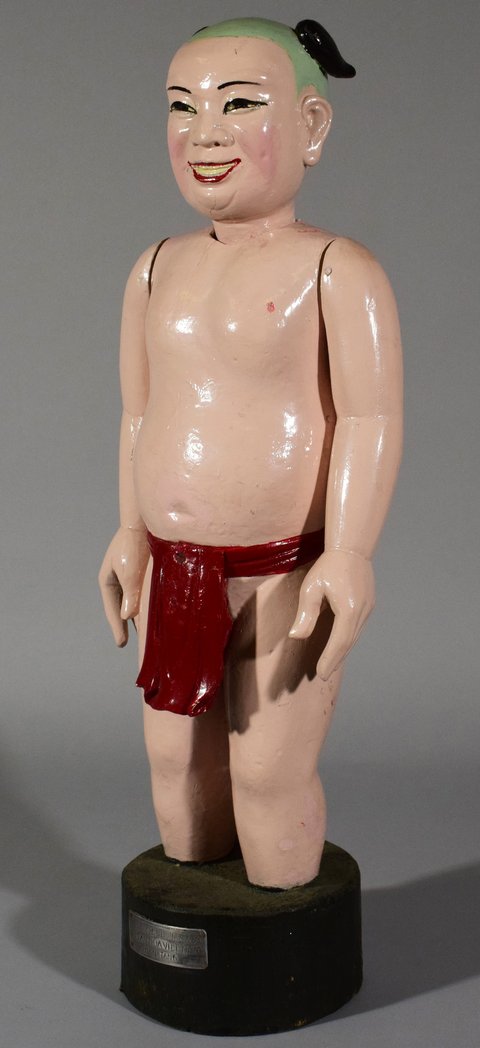
Chu Teu, Ansager (Hanoi um 1975) Holz, geschnitzt, bemalt
© Staatliche Kunstsammlungen Dresden, Puppentheatersammlung
This official gift is an exceptionally expressive piece with a number of unusual features. While other Tễus often wear a long waistcoat, this figure is dressed only in a red loincloth, above which his characteristic round belly hangs. The equally typical tufts of hair that often stand out on either side like two little brushes are, in this case, stylised as buns that lie flat against his turquoise-painted scalp. The figure’s unusually small head8 can move, as can the arms, but the mechanism is missing. Like many other puppets, during the performance, Tễu’s feet are in the water, so they are not carved on the figure. Instead, the legs end in a black base that underlines the sculptural quality of the figure while also, on a purely practical level, buoying it up as a float. The most striking feature of this Tễu, however, is his subtle smile, which suggests a relatively refined sense of humour. Altogether, the figure comes across as comparatively small and delicate. Inge Borde-Klein herself described it as a “replica”9 and as the result of “four days of carving”10. However, the layers of paint that can be seen in damaged areas, along with the slit and the “decommissioned” mechanism on the back of the figure suggest that the figure had been used in performances before being prepared for the foreign guest and having a plaque attached.
The generous gift was not, of course, intended for the visitor’s private use; it was a gift for the GDR, represented by the SKD’s Puppentheatersammlung. Inge Borde-Klein was a friend of Rolf Mäser (1925–2007), the director of the collection from 1960 to 1991, and after her return, the two exchanged correspondence on what would be a good (and publicity-generating) opportunity to present the gift to the collection. That opportunity came at the start of 1977, when the Puppentheatersammlung was preparing its largest exhibition to date, for its 25th anniversary. An exhibition in the Klingersaal hall at the Albertinum, entitled “Puppetry Today and Yesterday”, was to present a broad cross-section of items from the collection. There were also plans to set up a department for non-European puppetry traditions. Tễu was to represent the rare Vietnamese genre of water puppetry alongside pieces exemplifying Egyptian, Indonesian and Indian theatrical genres. Inge Borde-Klein was thus planning to attend the exhibition opening in Dresden and to present the Tễu to the collection as a gift. The items of correspondence that have survived do not show for certain whether that well-publicised presentation actually took place. Neither are there any photographs indicating how the figure was exhibited. However, the Tễu is listed among the exhibits, and Rolf Mäser repeatedly mentioned – for example in an article in the Sächsische Zeitung newspaper11 – the exceptional nature of this piece they were planning to exhibit. We can thus take it as read that, between 11 February and 24 April 1977, more than 110,000 visitors saw the Tễu in the Albertinum. In 1990, on the initiative of Inge Borde-Klein, the Dresden Tễu was loaned to Berlin for another exhibition entitled “Everyday Vietnamese Culture”, the final step to date in the figure’s career as a star exhibit. He did get some company when the friends association for the Puppentheatersammlung purchased four water puppets from a private collection in 2012, but the latest purchase marks an exponential increase in the holdings. And even if this elegant, well-preserved individual does not quite fit into the crowd of far more roughly hewn and worn-looking “associates”, it is, finally, part of an ensemble – and the vacant position of the comic protagonist has now, eventually, been filled.
This text was first published in the Dresdener Kunstblätter in issue 3/2020 "romantisch revolutionär" ("romantically revolutionary").
* Our thanks go to Lars Rebehn, curator of the Puppentheatersammlung, for his work on this article.
1 It is first mentioned on a 12th-century stele; cf., for example, Trần Văn Khê, Marionnettes sur eau du Vietnam, Paris 1984, p. 39.
2 The Weltmuseum Wien has a complete set; cf. Christian Schicklgruber, Ritus zur Freude der Ahnen. Das Wasserpuppentheater in Vietnam im Allgemeinen, aber auch im Dorf Ra im Besonderen, in: Archiv für Völkerkunde 59/60 (2009), pp. 59–94.
3 Having studied the violin and music education, Borde-Klein started out in puppetry in 1947 and chaired the Central Working Group for Amateur Puppetry from 1958 to 1968.
4 Borde-Klein herself came across the phenomenon in a travel report by Kurt and Jeanne Stern. The first European guest performance took place in France in 1984.
5 Inge Borde, Das Lächeln des CHU TEU, in: Mitteilungen. Staatliche Puppentheatersammlung Dresden 19 (1976), No. 1/2, pp. 33–39.
6 ibid., p. 35.
7 ibid., p. 39.
8 Many other Tễus have quite a large head in comparison with their body, and look far more like a caricature.
9 Card sent by Inge Borde-Klein to Rolf Mäser, 21.12.1975; see Staatliche Kunstsammlungen Dresden, Puppentheatersammlung, archive, file on Inge Borde-Klein.
10 From Inge Borde-Klein to Rolf Mäser, 10.2.1977; ibid.
11 Rolf Mäser, Spaßmacher Chu Teu, eine vietnamesische Wassermarionette, in: Sächsische Zeitung dated 16.3.1977.

Also of interest:
“The Global GDR – A Transcultural History of Art (1949–1990)”
For the “Counterpoints” project, the SKD are studying the international history of the East German cultural sector - a project about the history of their own collection; about dialogue and networking. Above all, however, it is about correcting the narrative describing that history as provincial and isolated from modernism. In June, TU Dresden’s Chair of Visual Culture Studies in a Global Context organised a conference on the ties between the GDR cultural sector and the Global South, working with the Albertinum and the TU Office for Academic Heritage, Scientific and Art Collections.
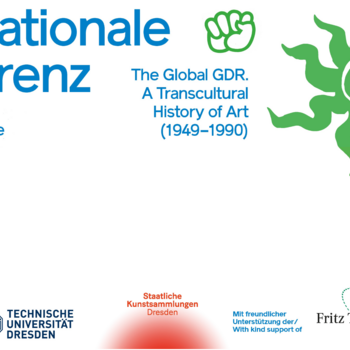
It is what it is
What happens when you give museum audiences a stack of pencils, a few sheets of paper, and an entire room lined with white paper? Dresden artist Artourette did just that as a part of the Children's Biennale at the Japanisches Palais.
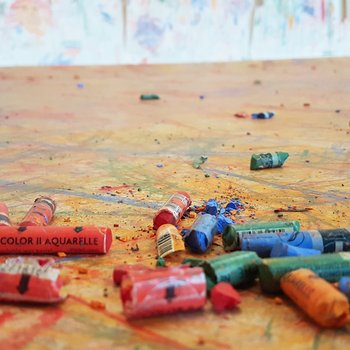
Spoon Archaeology meets Lunch for Locals
The Spoon Archaeology exhibition is designed as a reaction to the EU ban on single-use tableware. But what will replace it? The designers Peter Eckart and Kai Linke, whose cutlery collections are on display in the Kunstgewerbemuseum this year, asked themselves that very question. It has to be sustainable and, of course, fit for purpose. The answer they have come up with has a far less futuristic ring to it than you might expect: the human hand. We join the Palais Café to try it out.
